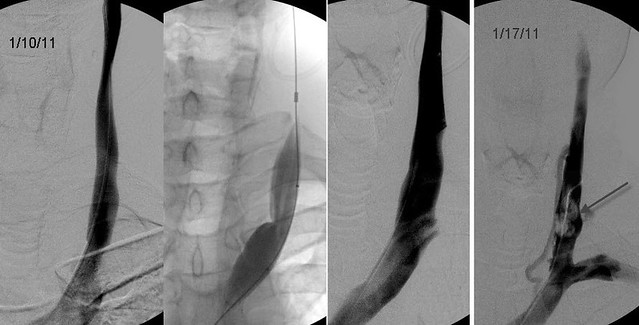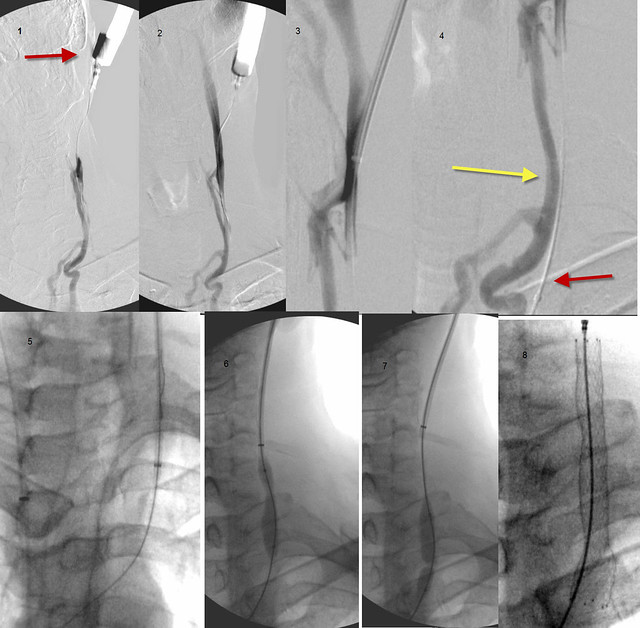Page 393 of 557
Re: DrSclafani answers some questions
Posted: Sun Sep 25, 2011 2:47 pm
by Cece
drsclafani wrote:
These images show an IVUS (center) to assure myself of a good apposition between stent and vein wall and nice IVUS (right) and venographic (left) images showing restoration of flow and diameter.
These images have gone the way of your profile picture! Flickr, so fickle....
Re: Dural sinus are safe with DrS
Posted: Sun Sep 25, 2011 3:34 pm
by Cece
drsclafani wrote:Lest the CCSVI world now spread a story that DrSclafani uses the Liberation Procedure as a recreational tool, let me end the rumor that the procedure room in Brooklyn, New York is my personal Disneyworld. I love m y work, but it ain't a game.

Indeed, Disney World is full of characters, but there is only one character in the Brooklyn procedure room.
Plus, at Disney World, lots of food. In Brooklyn, no food until you make it to the turkey sandwich in the recovery room.
Also, at Disney World, the magic is pretend. Not so in the Brooklyn procedure room.
Re: DrSclafani answers some questions
Posted: Sun Sep 25, 2011 3:47 pm
by PointsNorth
I thought that the turkey sandwich was pretty good. Altho it was 6pm and I hadn't eaten all day!
Re: DrSclafani answers some questions
Posted: Sun Sep 25, 2011 3:49 pm
by drsclafani
Cece wrote:drsclafani wrote:
these are images of the two venograms performed in January. The initial study is on the left three panels and shows an angioplasty of a lesion that is not well seen. A week later there is extensive thrombus in the LIJV.
These are very interesting images. There is a visible collateral in the fourth panel. It definitely looks like the blood flow had worsened from the patient's initial baseline. .
Had there been no collateral there, thrombosis would have continued to propogate toward the head
Re: DrSclafani answers some questions
Posted: Sun Sep 25, 2011 4:09 pm
by Cece
drsclafani wrote:When he consulted me, i learned of the thrombosis so I was preparing to address this issue. A surface ultrasound confirmed the thrombosis. I began a complete diagnostic venogram but very quickly abandoned attempts to catheterize this vein from the femoral side of the catheterizationand went on to direct puncture of the high portion of the IJV via ultrasound guidance.

in window 1 you can see the red arrow pointing to the neck catheterization.
in window 4 most of the contrast material is opacifying the anterior jugular vein (yellow arrow) . You can see how it parallels the IJV (red arrow)
It's interesting that it didn't go into the verts but into the anterior jugular instead.
What a difference too between this not-there jugular and the one in the images from January.
Bridging the thrombosis with a guidewire is the most important and often the most difficult component of this procedure. I used a guidewire first but it just kept getting hung up on this organized thrombus. Next i used a stiffer wire with a J on the tip to atraumatically push the wire through the clot. In this case this technique worked.
Glad to hear it worked.
I had no idea back in the early days that we would see people lose their jugulars after an attempt to fix their jugulars. It's awful.
So first the guidewire, then the stiffer wire with a 'J' tip, then the stiffer-yet back end of a wire, then a cutting needle if lined up straight (risky), then potentially intravascular RF (risky).
If it didnt work, then I would use the stiffer back end of a wire to push through the clot. If that failed, i would use a cutting needle IF i could assure myself that I was properly lining up the vein on both sides. This is often very challenging because there are adjacent structures such as lung, arteries, sometimes bowels (not in this situation) and other structures that might be injured if the alignment of the needle and the target was not perfect.
Another newer technique is radiofrequency delivery of heat energy to burn through the organized clot. However risks of perforation occur with this technique as well.
Thankfully, i was able to get the wire into the more central vein. and then i predilated the wire track.
How did you predilate the wire track? I am not sure what that means.
Next I used a snare to grab a wire from the femoral side and pull it through the thrombosis.
So you had a wire from the upper jugular rendez-vous access point that made it through to the other side.
You also had a wire that had come up from the femoral access point in the groin.
I am not sure which side the snare came from or how it got where it needed to be?
The wire that had come up from the groin access point got snared and pulled across to the upper side.
It is complicated but step-by-step it makes sense.
Now with the wire across the thrombus, i was able to deploy some stents, and then balloon them (not shown) against the vein wall to get a good seal.
The stent balloooning just forces the thrombus open? The thrombus would essentially be squished between the stent and the vein wall, right? Do the remains of the thrombus cause any problems for endothelization?
These images show an IVUS (center) to assure myself of a good apposition between stent and vein wall and nice IVUS (right) and venographic (left) images showing restoration of flow and diameter.
I will take your word for it: a beautiful restoration of flow and diameter. It is amazing to take a completely blocked vein and make it work again.
Re: DrSclafani answers some questions
Posted: Sun Sep 25, 2011 4:35 pm
by Cece
PointsNorth wrote:I thought that the turkey sandwich was pretty good. Altho it was 6pm and I hadn't eaten all day!
The turkey sandwich was great. I fare poorly when I skip meals!
Re: DrSclafani answers some questions
Posted: Sun Sep 25, 2011 5:07 pm
by CD
Dr S. I am trying to find out the lifespan of stents. I have 3 Ev3 mesh titanium with nickle alloy stents placed in my left IJV. They do overlap each other from two procedures. Mine look similar to your above image with the stent/s. Mine may go even higher. I have a small neck. You can see and feel them.

Cece said
I don't think we know yet what the lifespan of stents will be when placed in the jugulars. They may be subject to more movement stress here than in more stable areas of the body. I can remember one person reporting that they'd had a stent fracture but only that one person
What is your opinion please?
CD
Re: DrSclafani answers some questions
Posted: Sun Sep 25, 2011 5:34 pm
by pklittle
Cece wrote:PointsNorth wrote:I thought that the turkey sandwich was pretty good. Altho it was 6pm and I hadn't eaten all day!
The turkey sandwich was great. I fare poorly when I skip meals!
I like cookies better.

Re: DrSclafani answers some questions
Posted: Sun Sep 25, 2011 5:37 pm
by msfire
Cece wrote:drsclafani wrote:Cece wrote:Any other strategies or concepts on the docket to be explored in 2012?
1. 12 month followups of patients treated in 2011
2. Development of CCSVI Centers of Excellence at American Access Care
3. Dural sinus and deep cerebral vein pressure measurements with IVUS before and after treatment
4. A Bigger and Better Symposium
5. PwMS talent show at the symposium
6. Greater networking worldwide
7. publishing, publishing, publishing
I do not know which to be more excited about. But let's see!
* 12 month follow-ups! It must be difficult with patients that are not local.
* "CCSVI Centers of Excellence"...sounds promising!
* pressure measurements, which I think is similar to what Dr. Tucker was suggesting.
* Glad to hear there are still plans for a symposium next year, and a bigger & better one to boot!
* ok, publishing, publishing, publishing is my favorite

12 month check ups, I'm up for that, any reason to be part of Dr.S's reserch/passion is good for me.

Re: Dural sinus are safe with DrS
Posted: Sun Sep 25, 2011 9:08 pm
by pelopidas
Cece wrote:drsclafani wrote:Lest the CCSVI world now spread a story that DrSclafani uses the Liberation Procedure as a recreational tool, let me end the rumor that the procedure room in Brooklyn, New York is my personal Disneyworld. I love m y work, but it ain't a game.

Indeed, Disney World is full of characters, but there is only one character in the Brooklyn procedure room.
Plus, at Disney World, lots of food. In Brooklyn, no food until you make it to the turkey sandwich in the recovery room.
Also, at Disney World, the magic is pretend. Not so in the Brooklyn procedure room.
Dr S.
after the procedure you performed, i do not struggle along with all the things i have to do everyday
my life is fun and easy like Disney World
maybe this is what the rumor was all about, MY personal Disney World
Re: DrSclafani answers some questions
Posted: Sun Sep 25, 2011 10:00 pm
by Algis
On (6) "Greater networking worldwide" any chance of opening a branch clinic in Taiwan?
Re: DrSclafani answers some questions
Posted: Sun Sep 25, 2011 10:21 pm
by NZer1
On (6) "Greater networking worldwide" any chance of opening a branch clinic in Taiwan?
"Greater networking worldwide" any chance of opening a branch clinic in New Zealand? Please

Re: DrSclafani answers some questions
Posted: Mon Sep 26, 2011 6:47 am
by Algis
New-York / Taipei / Wellington is a nice flight

Re: DrSclafani answers some questions
Posted: Mon Sep 26, 2011 7:46 am
by pklittle
drsclafani wrote:
7. publishing, publishing, publishing
Yes, Yes,Yes !!!

Re: DrSclafani answers some questions
Posted: Mon Sep 26, 2011 10:30 am
by HappyPoet
DrS, it's wonderful that your rendezvous procedure was successful in helping to open the vein for stenting. Your success will give hope to those who lost their improvements when their IJVs closed.
What type of blockages are the most difficult to get through with guidewires: blood clots, intimal hyperplasia, or scar tissue? Did I miss any types of blockages? What factors contribute to how difficult a blockage is to get through with the guidewires? Also, is there any kind of rendezvousesque procedure available for the Azygos vein?
Regarding picture No. 8, what does the indentation on the left side in the upper stent signify and what factors might account for that portion of the stent not fully opening? Suddenly occurring to me is what about the other side of the stent that can't be seen? Can IRs see the outside of the vein/stent from all sides?
Edit: Do you have any images that show the tips of the two guidewires (one wire approaching from above the clot and the other wire approaching from below the clot) close to each other or meeting? Thanks!


